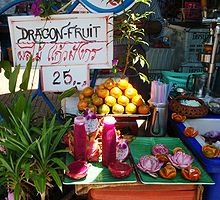Mi debilidad, la hermosa flor de la Pitahaya
A pitaya (pronounced /pɨˈtaɪ.ə/) or pitahaya (English pronunciation: /ˌpɪtəˈhaɪ.ə/) is the fruit of several cactus species, most importantly of the genus Hylocereus (sweet pitayas). These fruit are commonly known as dragon fruit – cf. Chinese huǒ lóng guǒ 火龍果/火龙果 "fire dragon fruit" and lóng zhū guǒ "dragon pearl fruit", or Vietnamese thanh long (green dragon). Other vernacular names are strawberry pear or nanettikafruit.
Native to Mexico and Central and South America, the vine-like epiphytic Hylocereus cacti are also cultivated in Asian countries such as Taiwan, Vietnam, Thailand, the Philippines, Sri Lanka and Malaysia. They are also found in Okinawa, Hawaii, Israel, northern Australia and southern China. Hylocereus blooms only at night; the large white fragrant flowers of the typical cactusflower shape are among those called "moonflower" or "Queen of the Night". Sweet pitayas have a creamy pulp and a delicate aroma.
If not otherwise stated, this article's content refers specifically to the pitayas of Hylocereus species, or "dragon fruit".
 Varieties
Varieties
The common Sour Pitaya or pitaya agria (S.)[1] in the Sonoran Desert has been an important food source for Native American peoples. The Seri people of northwestern Mexico still harvest the highly appreciated fruit[2], and call the plant ziix is ccapxl – "thing whose fruit is sour". The fruit of related species, such as S. queretaroensisand Dagger Cactus (S. griseus)[3], are also locally important food. Somewhat confusingly, the Organ Pipe Cactus (S. thurberi) fruit (called ool by the Seris) is the pitahaya dulce ("sweet pitahaya") of its native lands, as dragon fruit are not grown there in numbers. It still has a more tart aroma than Hylocereus fruit, described as somewhat reminiscent of watermelon; it has some uses in folk medicine.
Fruits of some other columnar cacti (mainly Cereeae) are also called "pitayas" – for example those of the Peruvian Apple Cactus (Cereus repandus).



No comments:
Post a Comment